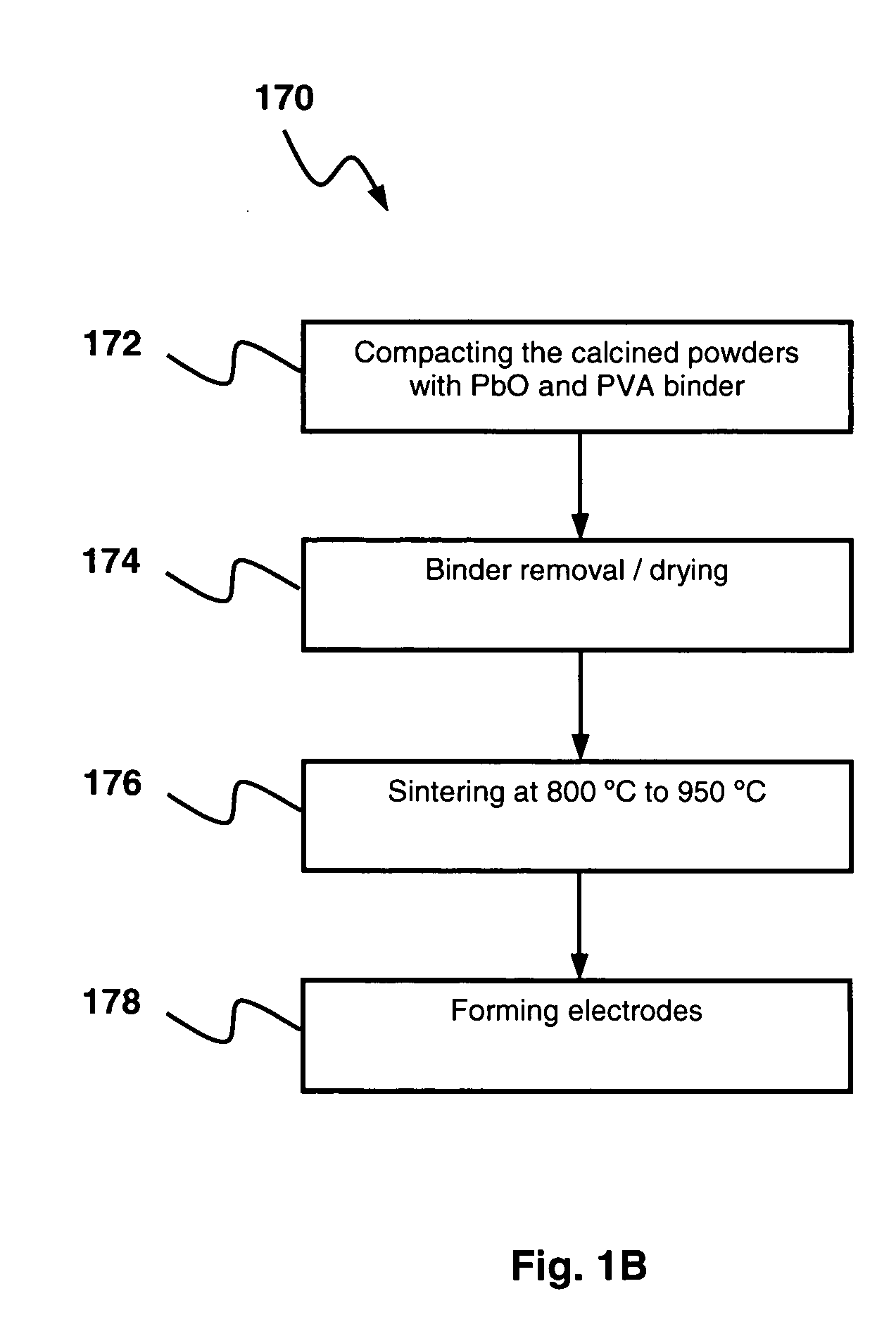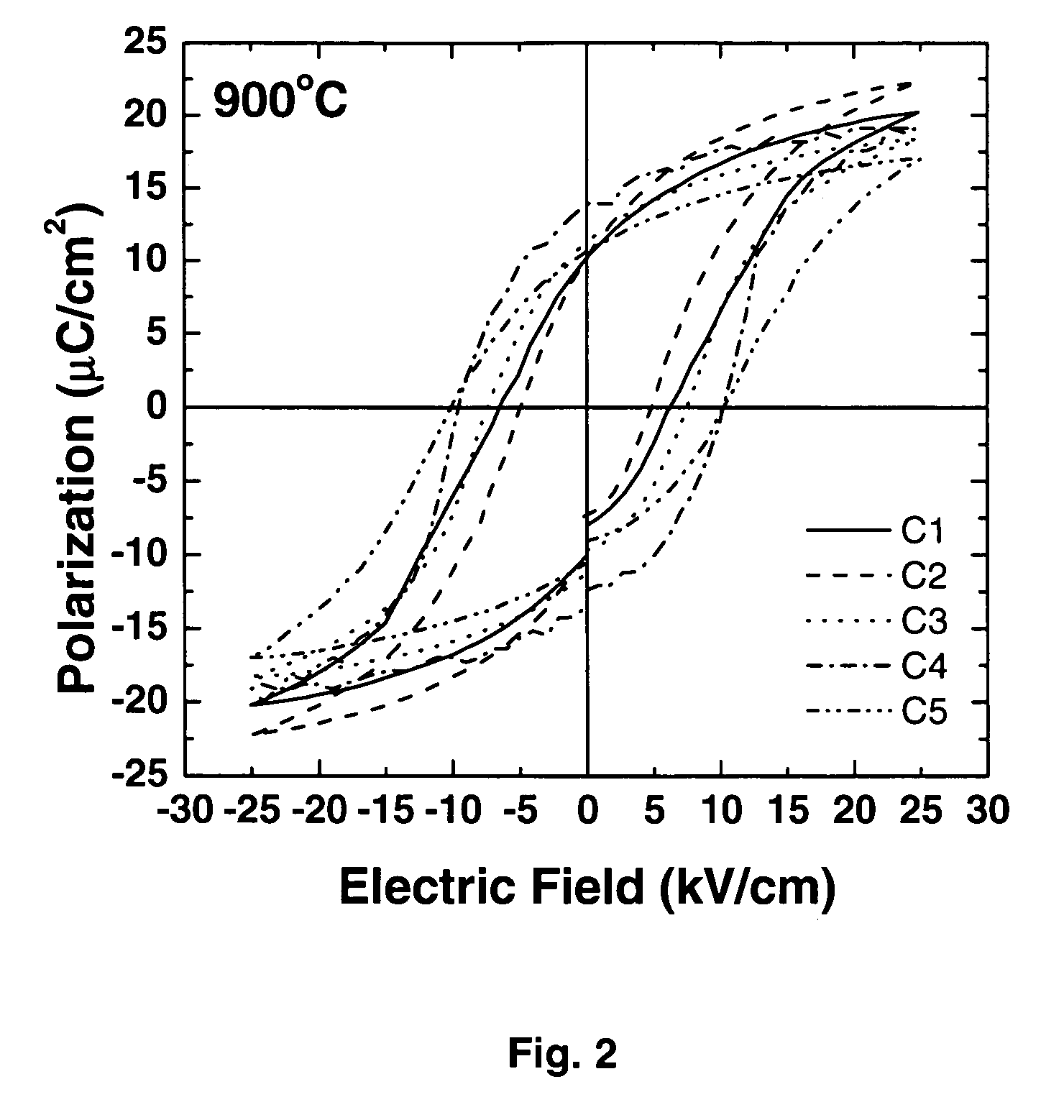Ferroelectric ceramic material with a low sintering temperature
a technology of ferroelectric ceramics and low sintering temperature, which is applied in the field of ferroelectric materials, can solve the problems of high manufacturing cost, high cost of electrode layers made of these precious materials, and device failure, and achieve the effects of suppressing the formation of pyrochlore phase, low cost, and promoting the formation of perovskite phas
- Summary
- Abstract
- Description
- Claims
- Application Information
AI Technical Summary
Benefits of technology
Problems solved by technology
Method used
Image
Examples
example 1
[0032] As illustrated in FIG. 1A, a preparation method 100 of the ferroelectric ceramic material of composition C5 with the composition as specified in Table 1 (0.10PNN-0.35PZN-0.15PMN-0.10PZ-0.30PT) starts from the synthesis of MgNb2O6 (MNO), ZnNb2O6 (ZNO) and NiNb2O6 (NNO) powder precursors.
[0033] To prepare MNO powder precursors, as shown in block 110, stoichiometric amount of high purity starting oxides, MgO (Kanto Chemical, 99.99%) and Nb2O5 (Kanto Chemical, 99.95%) are mixed in ethanol using a planetary ball mill for 24 hours, in an agate container with agate balls as the grinding media. The milled powders are then dried at 70° C. and collected through a 45 μm sieve. These powders are compacted and calcined at a temperature of 950° C. to 1050° C., for example about 1000° C., for 2 hours to form single columbite phase according to the X-Ray Diffraction (XRD) result (not shown). The calcined powders are then crushed and milled in ethanol for 8 hours using the same agate contain...
example 2
[0041] Another composition C4 as specified in Table 1 (0.20PNN-0.20PZN-0.10PMN-0.15PZ-0.35PT), may be produced through the same processing route as described in Example 1.
[0042] As shown in Table 2, the density of C4 test sample increases from 6.87 to 7.59 g / cm3, when the sintering temperature increases from 800 to 850° C. Upon sintering at a higher temperature above 850° C., the density does not increase but slightly declines. However, the maximum dielectric constant and piezoelectric coefficient for C4 are obtained after sintering at 900° C., which are 1900 (1 kHz) and 357 pC / N (FIG. 3), respectively. The remnant polarization increases with sintering temperature until 950° C., and is 13.9 μC / cm2 after sintering at 900° C. (Table 2 and FIG. 2). Temperature dependence of the dielectric constant indicates that this composition has a Curie temperature of 219° C., as shown in FIG. 4.
example 3
[0043] Another ceramic composition C3 as specified in Table 1 (0.30PNN-0.10PZN-0.10PMN-0.15PZ-0.35PT), may be produced through the same processing route as described in Example 1.
[0044] As shown in Table 2, the density of C3 test sample increases from 6.46 to 7.63 g / cm3 when sintering temperature increases from 800 to 850° C. Upon sintering at a higher temperature of above 850° C., the density does not increase but slightly declines. However, the maximum dielectric constant for C3 is obtained after sintering at 900° C., which is 2233 at 1 kHz. The remnant polarization and piezoelectric coefficient increase with sintering temperature until 950° C., and they are 13.6 μC / cm2 and 376 pC / N, respectively, as listed in Table 2. Temperature dependence of the dielectric constant indicates that this composition has a Curie temperature of 183° C., as shown in FIG. 4.
PUM
| Property | Measurement | Unit |
|---|---|---|
| temperature | aaaaa | aaaaa |
| temperature | aaaaa | aaaaa |
| temperature | aaaaa | aaaaa |
Abstract
Description
Claims
Application Information
 Login to View More
Login to View More - R&D
- Intellectual Property
- Life Sciences
- Materials
- Tech Scout
- Unparalleled Data Quality
- Higher Quality Content
- 60% Fewer Hallucinations
Browse by: Latest US Patents, China's latest patents, Technical Efficacy Thesaurus, Application Domain, Technology Topic, Popular Technical Reports.
© 2025 PatSnap. All rights reserved.Legal|Privacy policy|Modern Slavery Act Transparency Statement|Sitemap|About US| Contact US: help@patsnap.com



